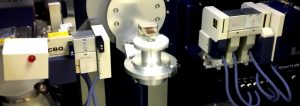
Questions? Contact Jennifer Forrester at jsforres@ncsu.edu.
Location: MRC room 303C
Watch this video for how to run an experiment using the Rigaku XRD.
Equipment Specifications
| Sealed Tube Generator |
- Voltage: 20 – 40kV max. operating voltage
- Current: 2 – 44mA max. operating current
|
| Cu X-ray Tube |
- Line Focus
- Focal Spot: 0.4 mm x 12.0 mm
|
| Parallel Beam Optics |
- Laterally graded incident beam multilayer x-ray mirror
- Automated mirror control and alignment
- Variable incident slit: 0.05 – 7.0 mm
- Height limiting slit: 2.0 – 10.0 mm
- Ge(220) x 2 monochromator
|
| Bragg-Brentano Optics |
- Variable incident slit: 0.05 – 7.0 mm
- Height limiting slit: 2.0 – 10.0 mm
- Soller Slits: 5o axial divergence
|
| Diffracted Beam Optics |
- Computer controlled receiving slits (x2): 0.05 mm – 20 mm
- Parallel Slit Analyzer: 5o angular divergence
- Kβ filter
- Graphite monochromator: curved or flat
|
| Sample Stages |
- Standard single specimen stage
- Eulerian cradle with φ and χ rotation for texture, reflectivity, and residual stress measurement
|
| Operating Mode |
- Bragg-Brentano in reflection geometry
- Grazing incidence X-ray diffraction (GIXRD)
- X-ray reflectivity (XRR)
- Rocking curve
- Phi scan
- Reciprocal space mapping
- Pole figure
|
In addition to this instrument, please see the list for other X-ray diffractometers on NC State’s campus:
- Panalytical Empyrean X-ray Diffractometer at AIF
- Bruker GADDS at AIF
- X-ray diffraction in Chemistry
- Neutron diffraction in Nuclear Engineering
